In advance of my summer work placement at the American Antiquarian Society, I discussed a slate of proposed activities with Chief Conservator Babette Gehnrich while in New York City. On their list was a housing project for manuscripts, standardized treatments of broadsides, and an introduction to digitization workflows for the Society’s collections. “Also,” she mentioned at the end of our conversation, “I have a poster to work on. Perhaps you might be interested in assisting with that? It’s large, so we will be able to maintain social distancing!”
“Of course,” I said, thinking it might be at most the requisite six feet in length for recommended social distancing.
Not long after my arrival in Worcester, followed by a 14-day quarantine in the charming Montvale Cottage,[1] I saw the poster in the flesh. It sat in a pile of folded and tattered fragments (Figure 1). A note perched on top of the heap read, “Preservation Needed.” Babette explained to me that the poster awaited the completion of the new conservation lab; its dimensions were thought to exceed those of the old lab’s equipment.
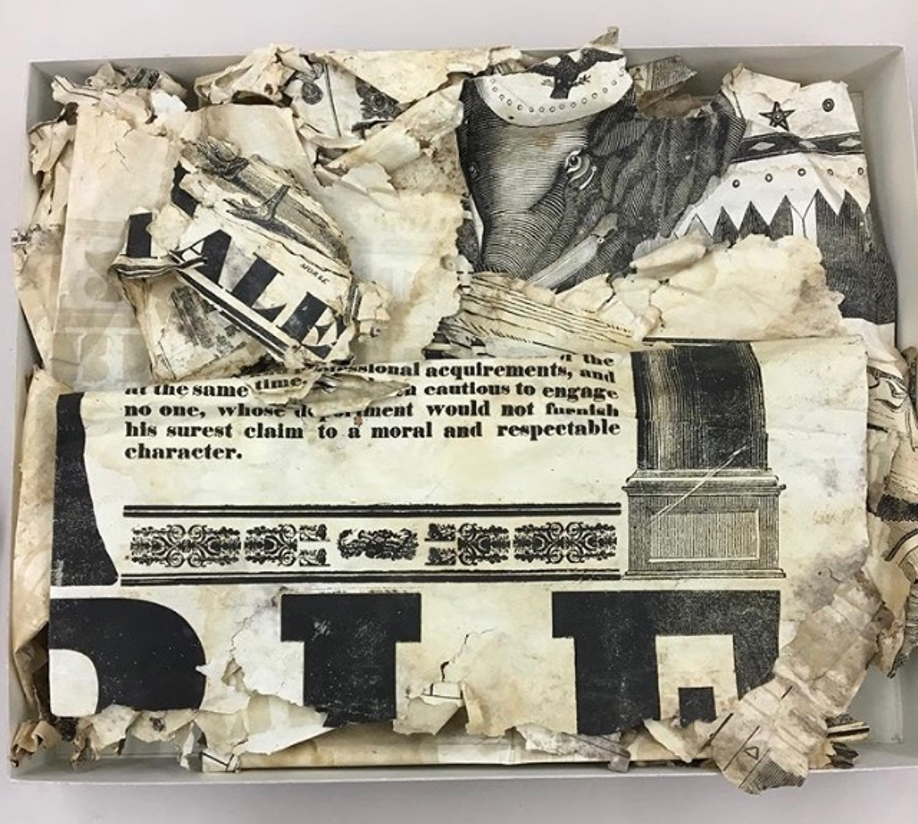
As we removed the fragments from the box, tigers, lion tamers, and large birds emerged. Typefaces of all kinds declared fantastic attractions: “King of the Vultures,” an orchestra containing fourteen musicians, and large cats “as docile as any of the domestic animals.” The printer’s name, Jared W. Bell, was clearly visible on what remained of the bottom edge (Figure 2). To our surprise, none of the large horizontal strips of the poster connected to one another. We estimated that the fragments comprised approximately fifty percent of a poster measuring about six feet wide and twelve feet tall. Only one smaller fragment, a very large “R” and the top of the elephant’s head, connected two of the large fragments (Figure 3).

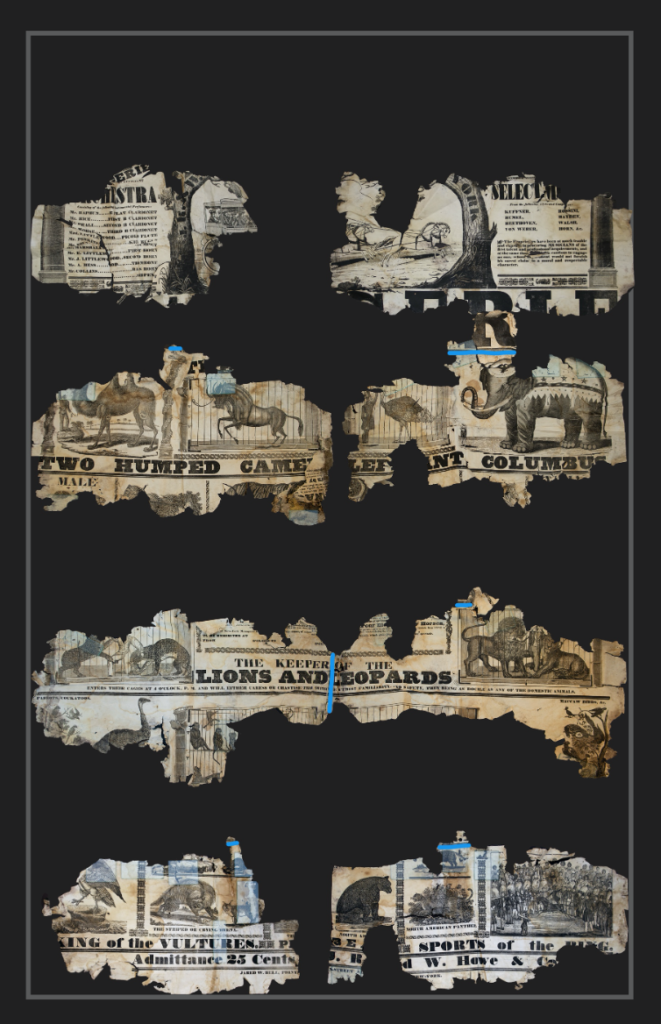
We decided that the large sections would be treated and stored as physically separate pieces of the same catalog item. Smaller fragments would also be treated and reattached to one of the larger sections if possible. Also in the box were a number of bundles of densely multi-layered fragments (Figure 4). In the course of advertising on the same building, it was possible that multiple posters could have been pasted over each other.[2] We assumed that each laminated packet probably contained one or two pieces from the menagerie poster and many layers of older ephemera.
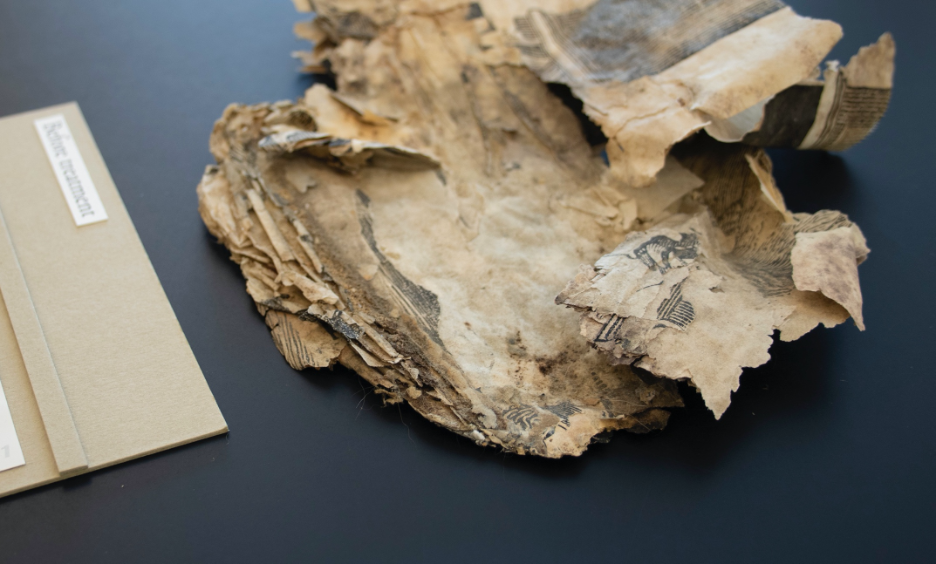
As Babette and Curator of Graphic Arts Lauren Hewes discussed the poster’s relative treatment priority, it became obvious that this was a major undertaking, and in demand by scholars. The poster was printed for display on buildings lining the parade route of an early traveling menagerie. Part of an advertising campaign, these posters were not typically saved; the fragments of this particular imprint comprise the only known surviving copy. The American Antiquarian Society acquired the pieces somewhat inadvertently; a dealer would have thrown the pile away, had Hewes not recognized Bell’s work out of the corner of her eye.
The top two largest fragments show two tree trunks bearing the name “J. R. & W. Howe & Co.” J. R. and W. Howe were owners of a traveling menagerie based in New York that toured New England during the 1830s.[3] These menagerie proprietors solicited Jared W. Bell’s printing operation because he was an innovator in the nascent medium of large-scale advertisement.[4] The New York printer had invested the exorbitant sum of $4,000[5] in a steam-powered Napier Cylinder Press, which allowed for significantly increased scale and efficiency. On another large-scale poster in the collection at the Society, Bell boasts alongside his name and business address that his press is “The Largest in the World” (Figure 5). [6]
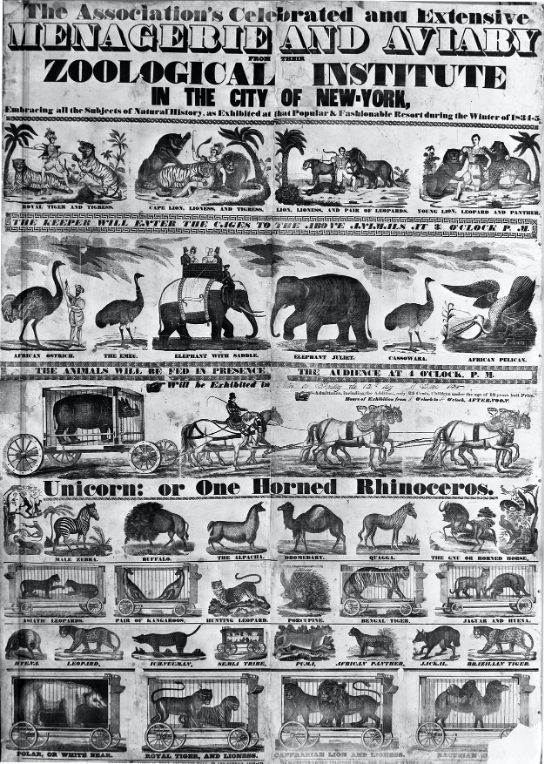
The poster features woodcuts from multiple artists, including Alfred A. Lansing and Joseph W. Morse.[7] Morse’s contributions included the arching trees and the “Elephant Columbus.” After printing, posters would be shipped in multiple sheets to towns along the menagerie’s route, assembled by an advance man on-site, and posted on the sides of buildings. The poster exhibits yellowed adhesive residue at the seams, as well as possible nail holes, evidence of this history of use (Figure 6).
The goal of conservation treatment was not only to stabilize the material artifact, but also to salvage and reconstruct unique visual information. Research interest in the poster is great; a photograph the lower right corner fragment, which shows a performance in an early circus ring, is already slated for publication.[8] If we needed a timelier motivation for our task, we couldn’t have asked for one; the work of my summer placement was set.
The white rag paper was strong in some areas and unstable in others. Mold had contributed to the breakdown of the fibers and left the sheet tissue-thin and delicate in patches. Overlapping areas of staining indicated that the poster had endured multiple “water events,” that is, periods of partial wetness and dryness (Figure 7). As dirty water containing impurities such as iron and organic debris travels through an absorbent piece of paper, it also solubilizes compounds present in the paper itself. Where the wetness stops, a brown stain or tideline occurs. The poster had been partially wet and dried many times.
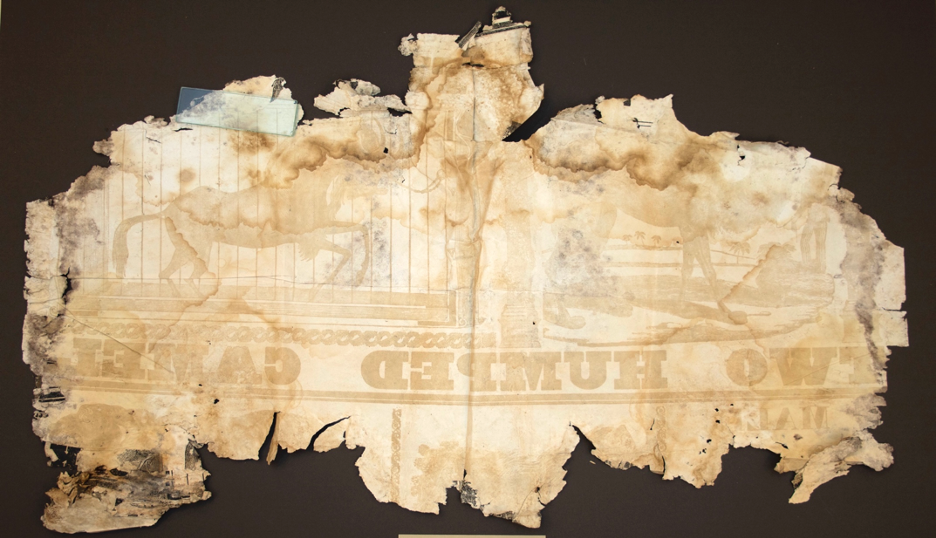
As we examined the largest fragments more closely, we discovered remains of overlapping sheets. The largest section was approximately 74 inches in width, with a single vertical seam in the middle. During the initial assessment, we were unable to determine the height of the sheets.
With care, we unfolded the sheets for surface cleaning. The procedure easily removed what appeared to be loosely-adhered, gritty, abrasive dirt, and dust. Powdered eraser crumbs were used in this process, and gently lifted up dirt as they rolled across the surface of the paper (Figure 8).
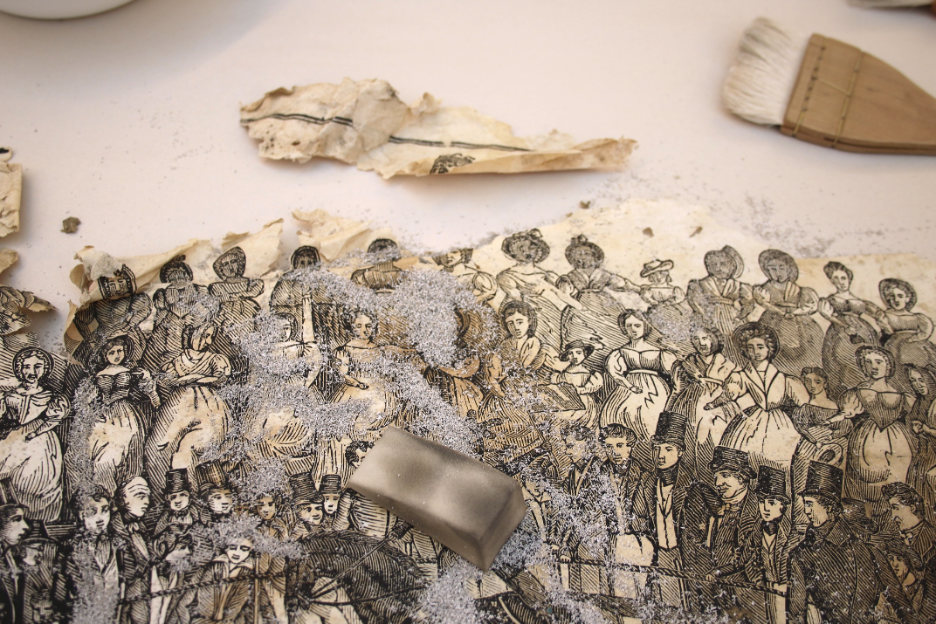
After surface cleaning, a gentle washing procedure was undertaken. The goals were two-fold: to improve the aesthetic appearance of the paper by reducing staining, and to solubilize and remove acidic byproducts that occur naturally in ageing paper. Luckily, the oil-based printing ink was reliably chemically and physically stable. In the most degraded areas of the print, we found that the ink actually helped hold the paper fibers together.
Due to their extensive complex tears, the fragments were washed by spraying on top of a moisture-permeable sheet of Hollytex, over an absorbent layer of Tek-wipe.[9] These materials ensure a gentle flow of liquid through the sheet, wicking away staining. Spray-washing instead of immersion reduces the chances of accidental damage during handling or unintended distortion in structurally compromised areas. We mixed several liters of a washing solution with a controlled pH and conductivity. This tactic is used to reduce staining overall in paper more effectively than simply washing with deionized water. During washing, the solution released a dramatic flow of deep, rust-colored compounds from the heavily stained areas of the paper (Figure 9). A number of tidelines were reduced.
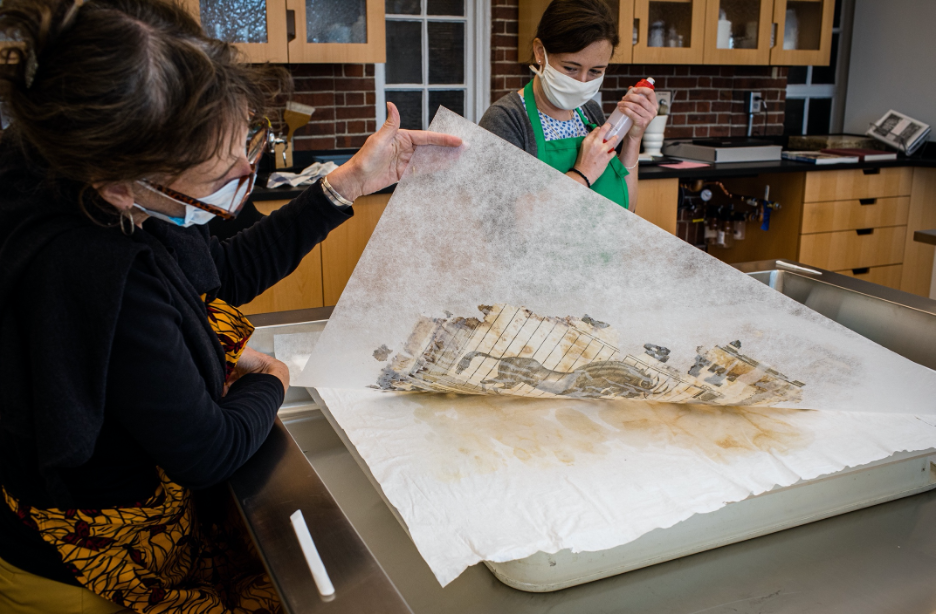
The results are consistent with the goals described above; legibility of the text and image contents is paramount. The appearance of a brand-new circus poster is not desirable, appropriate, or within the scope of treatment. Had a full restoration of the print been the goal, we would have targeted each stain individually in a more localized procedure and attempted to return the paper to an unstained appearance.
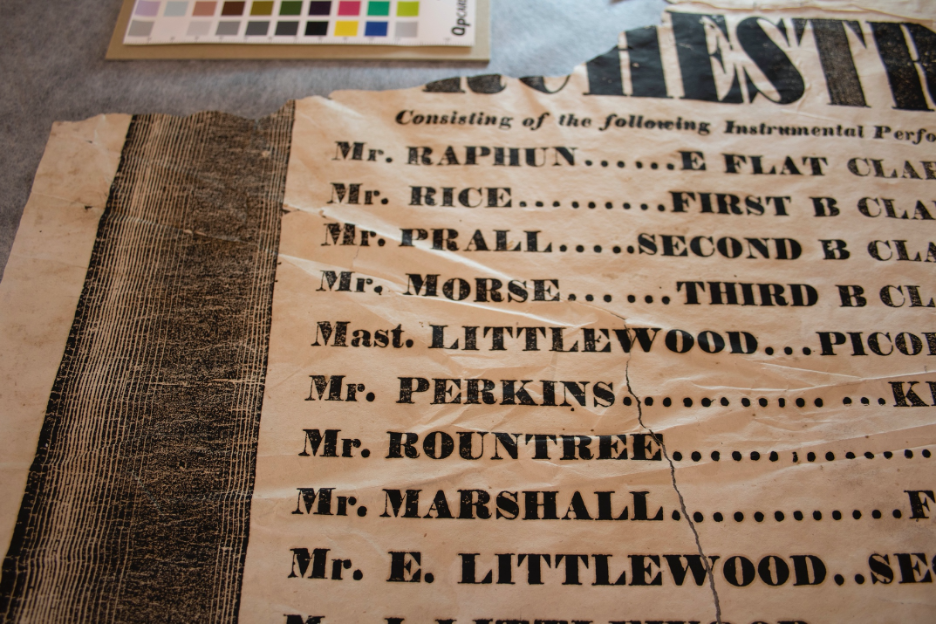
Curiously, the wet treatment had less of an effect on deep creases in the paper than anticipated. After washing and drying, the paper returned to its crinkled state (Figure 10). The creases had a long memory. Babette and I mused upon the various causes of this. Perhaps they were present when the sheets were originally posted with paste on the side of a house. Perhaps they were from the poster’s second life in a basement or attic, folded and rolled over on itself, as it went through several cycles of wetting and drying over the decades.
After washing the sections, we returned to the smaller fragments. During humidification and delamination, we made a striking discovery: the bundles of laminated paper, crusty with dirt, were from the same poster (Figures 11 and 12). They were not, as originally assumed, layers from other prints, but rather a multitude of jigsaw puzzle pieces belonging to the main poster. We realized that more than fifty percent of the poster had survived as we arranged the smaller pieces (Figure 13). This discovery also threw light on the possible circumstances of the poster’s storage. Fragments were adhered face to face and back to back, from different sections of the poster. The packets appeared to be from areas that had endured multiple cycles of moisture and drying and had become adhered to one another.

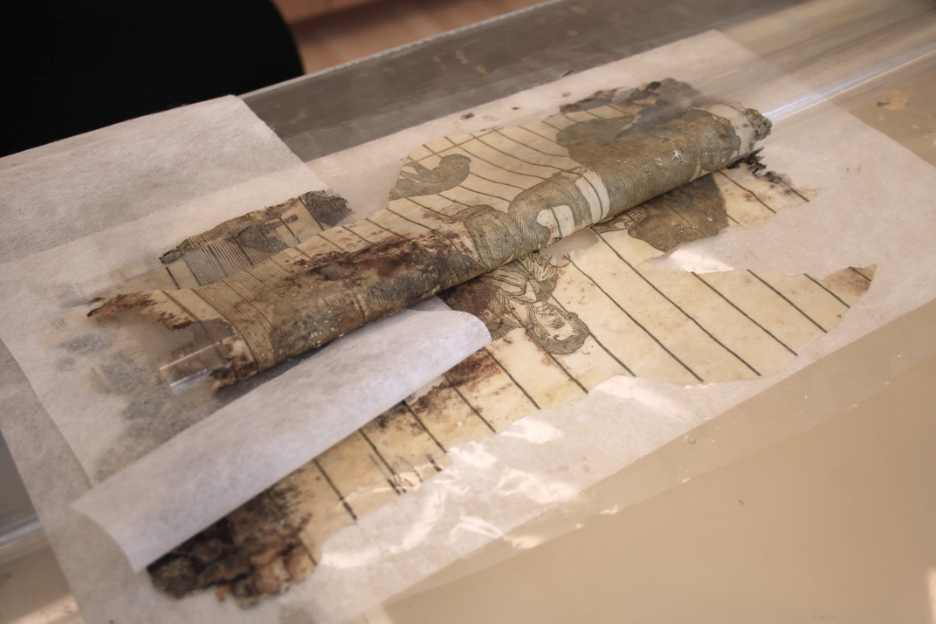
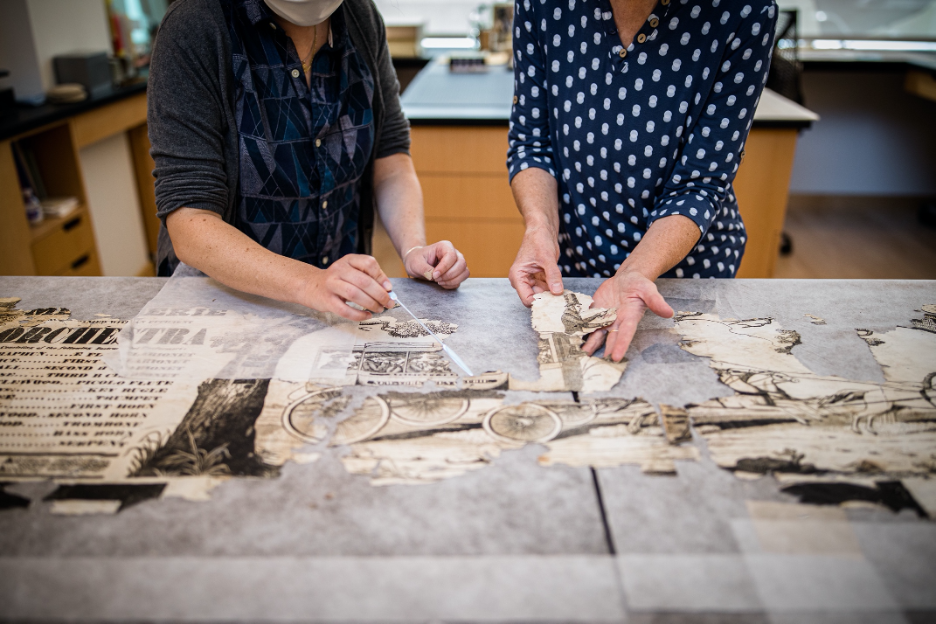
As we uncovered more fragments from the laminated bundles and placed them into position, we were able to reconstruct edges and seams and determine the sheet size. The poster was assembled from three rows of horizontally printed sheets, with a bottom row slightly shorter in height: six 25 inch by 38 inch sheets, with two shorter sheets measuring 18 inches by 38 inches comprising the bottom row. We estimate that the poster measured approximately 6 feet wide and 7.5 feet tall when fully assembled (Figure 14).
Initially, we proposed to line the fragments with a strong tissue. However, as treatment progressed, the delicate state of many areas became more apparent. In addition, the great number of smaller and smaller fragments to be attached meant that the poster was a more complex object than we originally understood. A revision of the original treatment proposed was deemed necessary. Lining would require manipulating these very delicate, complex areas while wet, a risky proposition. Instead, the treatment was modified to simply repair the tears and reattach fragments. Then, housing would be determined based on each fragment’s size. They would be encapsulated in polyester film with a sheet of backing material for added stability.
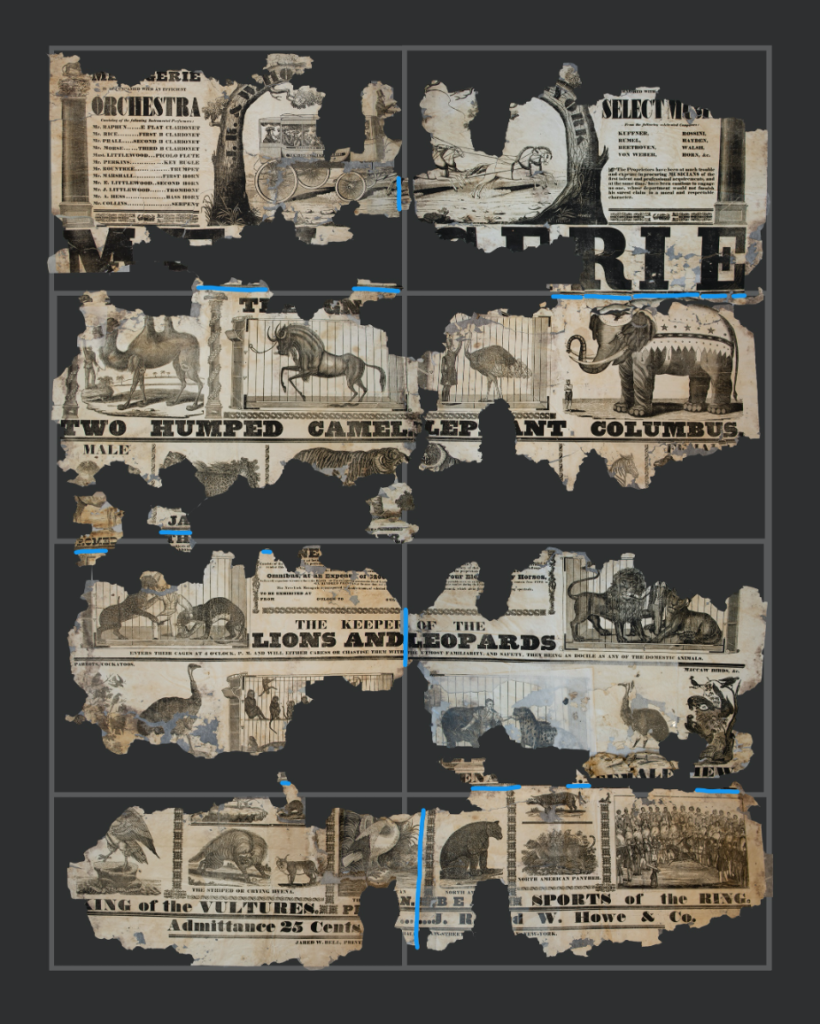
As my contribution to the treatment of this early menagerie poster ends, I reflect on the role of the conservator in 2020. One of the greatest privileges of this placement was to learn from the scholarly community of researchers and staff at the American Antiquarian Society. How can I anticipate the questions they might want to answer when investigating objects such as this poster? Advertisements were not meant to survive. Their nail holes and adhesive stains are not damage, but evidence of their original use as ephemeral media. Although impermanent, visual culture in entertainment advertising provides insight to the values of the broader public at the time.
In the course of this treatment, we chose to reduce evidence of the poster’s degradation and poor storage conditions, in favor of making the graphic media more legible and hopefully, prolonging the lifespan of the paper. In this case, the history of degradation and damage is less important than the image contents. But I also wish to acknowledge that even cleaning destroys artifactual information and such decisions should be made intentionally.[10] After all, museums are not neutral, libraries are not neutral, and conservation is not neutral. How might the preservation of one aspect of an artifact obscure its other histories and untold stories? I consider these questions as I continue my education and training in the profession.
I am tremendously grateful to the staff and council of the American Antiquarian Society for allowing me to learn and work during the COVID-19 pandemic. I look forward to the day when the poster is available for research in the digital catalogue and in the reading room at Antiquarian Hall.
Further Reading:
Wittmann, Matthew. Circus and the City: New York, 1793-2010 New York, and New Haven/London: Bard Graduate Center and Yale University Press, 2012.
— “Menageries and Markets.” Common-Place: The Interactive Journal of Early American Life 12, no. 1 (Fall 2011). Accessed August 21, 2020. http://commonplace.online/article/menageries-and-markets/.
Brooks, Mary M., and Dinah Eastop. “Matter Out of Place: Paradigms for Analyzing Textile Cleaning.” Journal of the American Institute for Conservation 45, (2006): 171-181. Accessed August 21, 2020. http://www.jstor.org/stable/40026689.
Rogers, Kory W. “Shelburne Museum’s Colchester Posters and Circus Advertising.” In The American Circus, edited by Susan Weber, Kenneth L. Ames, and Matthew Wittmann, 136-151. New York and New Haven/London: Bard Graduate Center and Yale University Press, 2012.
 Abigail Slawik is an Andrew W. Mellon Foundation Fellow in Library and Archives Conservation, beginning her second year in the dual MS/MA program in Art Conservation and Art History at the Conservation Center in the Institute of Fine Arts, NYU. She received her BFA in Studio Art also from NYU, and completed conservation internships at the Minnesota Historical Society and KCI Conservation, a private art conservation firm in Minneapolis, Minnesota.
Abigail Slawik is an Andrew W. Mellon Foundation Fellow in Library and Archives Conservation, beginning her second year in the dual MS/MA program in Art Conservation and Art History at the Conservation Center in the Institute of Fine Arts, NYU. She received her BFA in Studio Art also from NYU, and completed conservation internships at the Minnesota Historical Society and KCI Conservation, a private art conservation firm in Minneapolis, Minnesota.
The author would like to extend special gratitude to Chief Curator and Curator of Graphic Arts Lauren Hewes, Photographer and Media Producer Nathan Fiske, Digital Expeditor Amanda Kondek, and Chief Conservator Babette Gehnrich for their particular insights and generosity during the course of her summer placement.
All photographs and graphics by the author except where otherwise noted.
[1] Address 0 Montvale Road, not recognized by Google maps and, therefore, problematic to even the most intrepid pizza delivery drivers during the COVID-19 pandemic.
[2] For an account of the removal of several layers of circus posters from the side of a house in Colchester, Vermont, see Kory W. Rogers, “Shelburne Museum’s Colchester Posters and Circus Advertising,” in The American Circus, ed. Susan Weber, Kenneth L. Ames, and Matthew Wittmann (New York and New Haven/London: Bard Graduate Center and Yale University Press, 2012), 136-151.
[3] Matthew Wittmann, Circus and the City: New York, 1793-2010 (New Haven and London: Bard Graduate Center and Yale University Press, 2012), 36-37.
[4] Wittmann, Circus and the City, 36.
[5] According to the CPI Inflation Calculator, this amount is equivalent to approximately $110,000 in 2020. https://www.in2013dollars.com/us/inflation/1836?amount=4000
[6] Quote transcribed from a reproduction of the same poster in the collection of the Shelburne Museum, Wittmann, Circus and the City, 108.
[7] Readers interested in a discussion of another of Bell’s circus posters in the American Antiquarian Society’s collection will find detailed technical information in Matthew Wittman’s article “Menageries and Markets,” Common-Place: The Interactive Journal of Early American Life 12, no. 1 (Fall 2011). http://commonplace.online/article/menageries-and-markets/, including discussion of the development of large-scale wooden type, innovations in wood engraving in the early 19th century, and Bell’s steam-powered Napier Cylinder Press.
[8] The image shows an early circus attraction in the ring: a “Dandy Jack,” or monkey trained to perform tricks while riding a pony or horse, Wittmann, Circus and the City, 28.
[9] For an inventory of these and other materials and tools in common use in book and paper conservation, see the American Institute for Conservation’s WIKI resource: http://www.conservation-wiki.com/wiki/BPG_Materials,_Equipment,_and_Tools.
[10] For a consideration of paradigms of cleaning in textile conservation, see Mary M. Brooks and Dinah Eastop, “Matter Out of Place: Paradigms for Analyzing Textile Cleaning,” in the Journal of the American Institute for Conservation 45 (2006), 171-181.



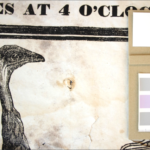
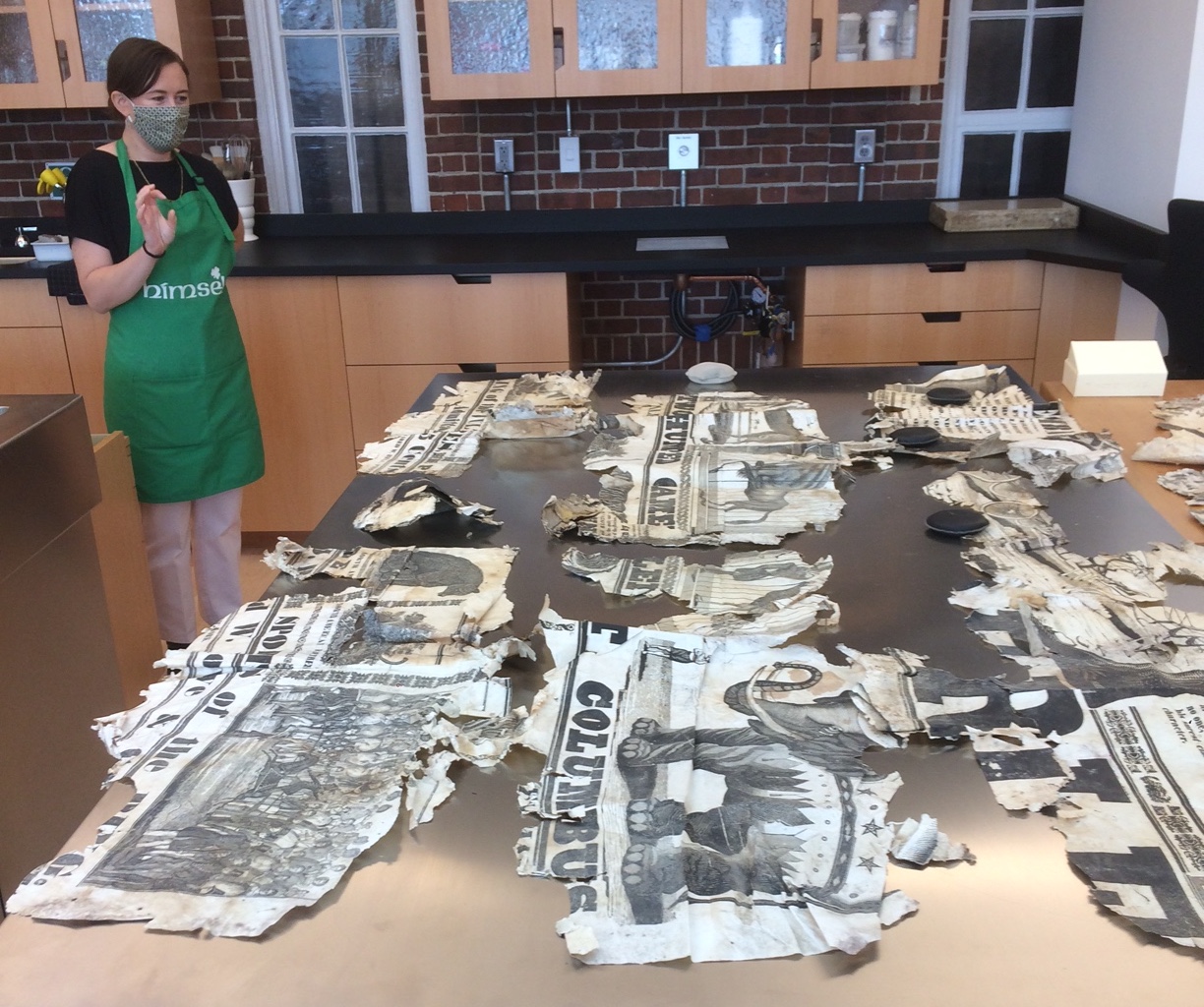
J. R. and William Howe Jr.’s New York Menagerie was operational December 1832 to 1834. An October 22, 1834 Easton, PA newspaper ad includes a different band member listing suggesting that the AAS bill is perhaps season of 1833. Columbus had formerly been named Mogul and remained on exhibition until passing in 1851. The menagerie story is in Stuart Thayer’s paper about early menageries in Bandwagon, journal of the Circus Historical Society, Jan-Feb 1992, p35, with Columbus in Nov-Dec 2000, p 51-52
Thank you for undertaking this astounding feat of conservation and print scholarship. The cuts alone, to say nothing of the typography, are all the more intriguing in their fragmentary form. It is gratifying to see advertising ephemera of this quality and age given such care.